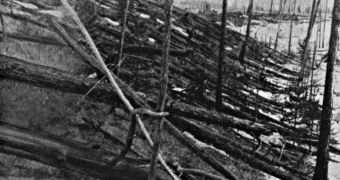On June 30, 1908, at about 7:00 a.m., a cosmic body entering Earth's atmosphere exploded several kilometers above ground in a remote region of Siberia, known as Tunguska, leveling more than 80 million trees spread over an area of 2,000 square kilometers. Estimations place the force of the explosion to about 200 times that of the nuclear device dropped over Hiroshima in 1945. No impact crater or fragments of the object have ever been found.
For more than a century scientists have been struggling to identify the object that triggered the event, but could never say for certain whether or not it was a meteoroid or a comet fragment. Geologist Evgeniy Kolesnikov of Moscow State University now brings clear evidence that the explosion was followed by the fall of acid rain, which seems to suggest that the cosmic body would have most likely been a cometary meteorite.
Analyses show that the north region of Lake Baikal contains peat deposits with unusually high amounts of uncommon nitrogen and carbon isotopes, dated back to the time of the Tunguska event. Such chemicals would have only been deposited through high levels of acid rain in the aftermath of a cometary meteorite burning in Earth's atmosphere, said Kolesnikov.
According to estimations, more than 200,000 tons of nitrogen would have made it into the atmosphere, nitrogen which, when subjected to a temperature of 2,200 to 2,700 degrees Celsius, bonded with atmospheric oxygen to form nitrogen oxides. These are well known to react with the water in the atmosphere, forming acids that fall to the ground in the form of precipitation. The analyses also indicate that the peat layer contains high amounts of iridium, about 50 times higher than normal levels, an element extremely rare on Earth but highly abundant in meteorites and comets.
"That something from outside Earth exploded there, I think is without doubt. There is definitely evidence of acid rain. An explosion at many thousands of degrees in the atmosphere is very efficient in producing nitrogen oxides. It's the same mechanism that creates hydrogen oxides after lightning," said atmospheric physicist Gabriele Curci of the University of L'Aquila.
And since the acid rain effects appear to be spread over a relatively wide area and no impact crater was ever found, it was most likely the result of a fragment exploding high in the atmosphere. "I don't think the meteorite hit the ground - it probably exploded at 9 or 10 kilometers of altitude," Curci said.
"The Tunguska cosmic body was rich in nitrogen, together with carbon and hydrogen. That means the body was a comet," said Natalya Kolesnikova of Moscow State University, part of the research team detailing the results of the investigation.

 14 DAY TRIAL //
14 DAY TRIAL //